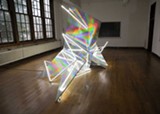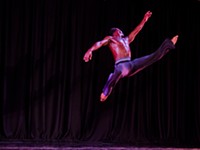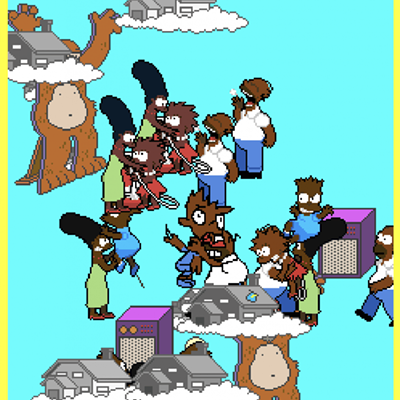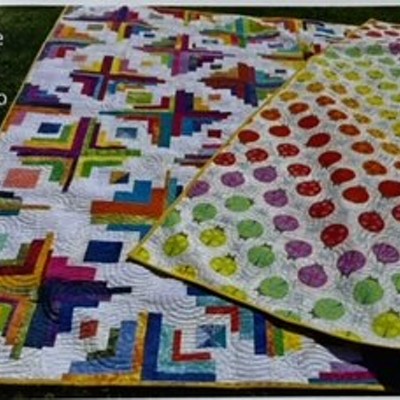[
{
"name": "500x250 Ad",
"insertPoint": "5",
"component": "15667920",
"parentWrapperClass": "",
"requiredCountToDisplay": "1"
}
]
Art enriches human life in many ways, some of which have nothing to do with acquiring and owning an object. When you interact with installations or performance pieces, you walk away empty-handed, but perhaps some expansion on the inside has occurred.
This past weekend -- and for the second consecutive year -- the former Medina High School was the site of "PLAY/GROUND" (artplaygroundny.com), a series of installations and performances created by dozens of artists based in Western New York. Located right in the village, the building was purchased for redevelopment by the Hungerford family of Medina, who last year approached the WNY art consultancy group Resource:Art about creating a cultural experience in the school.
Having partially grown up in Clifton Springs, a tiny Ontario County village east of Rochester, I'm particularly appreciative of cultural amenities popping up in small, rural towns; teen me would have been overjoyed if the Main Street Arts gallery (and now, the up-and-coming Sulfur Books) had existed when I lived in what, at the time, felt like a cultural vacuum. The addition of galleries, art events, and book stores with literary programs benefit the residents of small towns directly. But they also have the indirect benefit of bringing tourist revenue in from the surrounding cities. And city slickers get to emerge from their bubbles for a while and remember how much state exists outside of the urban pockets.
The weekend-long "PLAY/GROUND" pop-up was co-presented again this year with Rochester and Buffalo-based arts organizations, including Rochester Contemporary Art Center and Hallwalls Contemporary Art Center. From Friday, September 27, to Sunday, September 29, the school featured installations and events presented by a set of returning and new artists.
I didn't catch the preview party on Friday night, which included performances by Buffalo's Torn Space Theater and Buffalo Aerial Dance, as well as DJ duo Sherri Miller and Mario Fanone. But on Saturday and Sunday, live music performed in the auditorium filled the halls, performers in Kyla Kegler's puppet show "Do You Think My Head Is Too Big" roamed the halls wearing huge papier-mache human and animal heads, and visitors popped in and out of classrooms, bathrooms, and the gym to experience each element of the spectacle.
I made the trip with CITY's News Editor Jeremy Moule, who grew up in Medina, and artist Megan Sullivan. Our little group first gravitated toward a quieter room across the hall, which turned out to be a locker room with toilet stalls and shower stations. A line wrapped around the room toward the adjoining space that was hidden by a black curtain with a silver asterisk painted on it. We queued up and chatted, taking in the fact that every single surface of the walls, lockers, stalls, ceilings, and floors was covered with freeform paintings and drawings by Brockport artist and Wall\Therapy alum Nate Hodge.
After 30 minutes in line, I was a bit concerned about seeing the rest of the spaces (we arrived in the afternoon and the venue closed at 5 p.m.). I considered stepping out of line and asking Jeremy and Megan to tell me what that room was like, but at this point we were close to the front and I decided to stick it out -- this wasn't a fast food line. Then a woman behind us started loudly complaining about how outrageous it was that the wait was so long, repeatedly lecturing the level-headed friend of the artist who chatted with visitors and ushered each next set of folks into the small room.
I had already asked the artist's friend if she could tell us what to expect. She said the artist, Caitlin Deibel, was creating "soul portraits" with individuals or small groups, and that her art in general was focused on healing. People were allowed to move along at their own pace, she explained, but most people weren't taking more than five minutes.
Without much more information, this description brought to mind the soulful, art-therapy-like performances presented by Megan Joy May, a former artist in residence at the Flower City Art Center, whose work is often not about the product but the process, the focus, the reflection, and the growth.
When I was up, I went in alone, vowing not to linger too long. An old-school projector was set up in the small anteroom to the locker room showers, bouncing a square of light onto the wall. Deibel explained that she wanted visitors to consider their light and shadow selves, and invited me to go into the adjoining shower room -- two narrow spaces separated by a central wall, each side filled with vases of dried plants and pods collected from nearby fields -- and select objects that I connected with to bring back to the projector. I brought back curved branches of delicately shivering leaves and rods of spiny thistle, and arranged them on the projector bed so that a sort of shadow archway formed on the wall, framing a spot for me to stand in the bright negative space. Then Deibel took my picture using my phone, and I went away with what sort of looked like a nature goth prom photo saved in my device.
So it made sense that the line was moving slowly. And perhaps this wasn't an experience for everyone -- I wondered if the woman who complained connected with what the artist was trying to do, or if she just got her selfie, some nebulous proof of having had an experience.
Back out in the hallway, our little group split up to check out the installations in the hallways, stairwells, and classrooms -- some filled with interactive elements, some transformed into strange, immersive environments.
I was delighted to check out the contributions by some regional artists I've followed for years, including Robin Whiteman. She transformed a locker room into a seemingly haunted treasure hunt, with her ceramic, cloth, lighting, and mixed media works filling many nooks in the dim space. In a hallway and up a staircase, sculptor Lee Hoag had set up "Beat Drop," a few of his large, imaginative assemblages that stood sentinel or seemed to trundle down the stairs just like students of decades past.
Elsewhere, Bethany Krull created a reliquary-like birdcage with ceramic bird bones nestled into a carpet of moss and flowers, suspended spot-lit in a cave-like janitor's closet. Krull's artist statement explained that this work, "The Canary is Long Dead," alludes to the cataclysmic effects of climate change, and warns us of the fate that awaits if we don't act.
Other installations were simply playful, hands-on delights, such as Buffalo-based Michael Bosworth's "Newton's Clock," which included deconstructed pinball machines reconfigured into stations that challenged visitors to keep the ball in motion as long as possible. Entering another room, I encountered Colleen Toledano's "The Field," which is essentially scaffolding to another world: steps and ladders led to holes cut in plywood, and by climbing them you could peek into a surreal lawn-like environment.
A particularly long classroom was transformed into "Rolling Thunder," which blended Buffalo artists Tom Holt and Quincy Koczka's love of creating things and skateboarding. The space was filled with sculptures (painted ramps and the like) "animated" by skateboarders. Serious Bart Simpson vibes.
Some installations were just downright cool, including Keith Lemley's "Symmetry Breaking" sculpture, a geometric construction with fluorescent lights and reflective surfaces that formed a huge prism-like object in the center of a classroom.
Lemley's sculpture was so stunningly pretty it seemed made for selfies -- I had to wait a bit to see the whole object because of all of the people snapping shots of themselves for the 'gram. Ditto for "Into the Void" by William Quintana and Christina Trautman. The installation was a room-consuming series of telescoping boxes with deepening hues and lights that held my gaze like a magnet. It brought to mind both a Dan Flavin light sculpture and a 1970s game show set.
Peeping into a different classroom I spied several folks laying on a pillowy sculpture, gazing up into a constructed canopy, taking the artists Marquis Burton and Tara Sasiadek up on their offer to use "Wave and Shore" as a place to pause and stretch time. Other installations in the spectacle were a bit inaccessible, and still others elicited some deeper and lasting considerations after viewers walked away.
"PLAY/GROUND" as an endeavor is not unlike the instances when groups of artists have done "takeovers" of unused buildings. One Rochester example is the 2015 "Compartmented" art takeover of the reading rooms at what is now Lyric Theatre, which happened between that building's use as a church and performance venue. This region is rife with old, underutilized spaces that can become art venues in a pinch, and these types of exhibitions point out the potential in breathing new life into them.
Rebecca Rafferty is CITY's arts and entertainment editor. She can be reached at [email protected].
Speaking of...
-

Culture Vulture
Jun 15, 2023 -
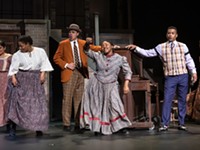
“Ragtime” evokes history through rhythm and rhyme
May 8, 2023 -

Six art shows you shouldn’t miss this fall
Sep 1, 2021 - More »
Latest in Art
More by Rebecca Rafferty
-

Beyond folklore
Apr 4, 2024 -

Partnership perks: Public Provisions @ Flour City Bread
Feb 24, 2024 -

Raison d’Art
Feb 19, 2024 - More »
